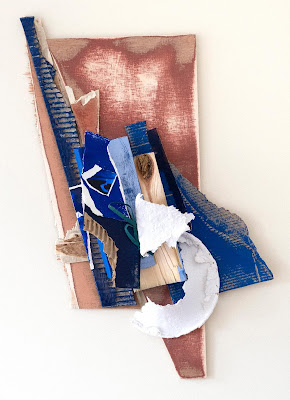Click on the image to enlarge
Sea Song
2014
Acrylic paint, canvas, collage, pencil, cardboard and
paper
83cm x 127cm
Terry Frost, in a lecture at Warwick University, repeated in
the Banbury Museum film of 2015, said that ‘when he got into abstract painting,
it was like writing poetry’, and in many ways that is true.
Read more: Frost, Family and Friends. The Banbury Years.
A poem made from words and the spaces between, becomes an
entity in its own right, as does an image made from visual elements and the
spaces between.
The spaces between can be vital as the words and the visual
elements, but the words and the shapes and colours dictate the spaces, and in abstract
art it is possible to create an interactive pictorial space on a physically
flat surface that does not depend on
illusory perspective.
In Sea Song, I wanted the colours, and the straight and torn edges to just touch and to almost touch, in a kind of ariel ballet, circumscribed with looping arcs of graphite, freely and confidently drawn, but located precisely to dynamically activate the coloured forms.
The surface area is large, so I wished to give the image a
visually homogenous quality, but also to have numerous points of visual
interest within it, like words, or groups of words within a poem or notes or successions
of notes within a musical composition.
So, as Terry rightly said, whilst making a painting can be
akin to making poetry, and possibly, complimentary
to it, visual art per se is unique and particular, and its essential character is manifestly and fundamentally different from the oral or the aural or
the written word and thus, is definitively noninterchangeable.
George Taylor
August 2025




